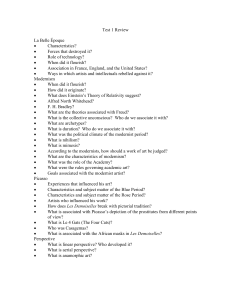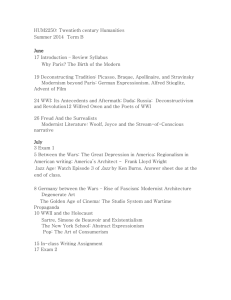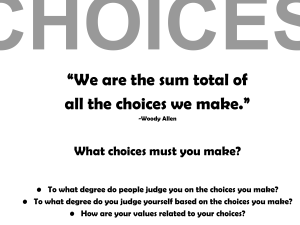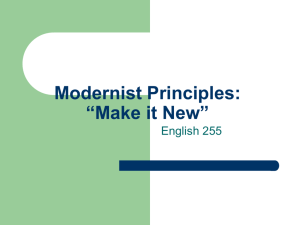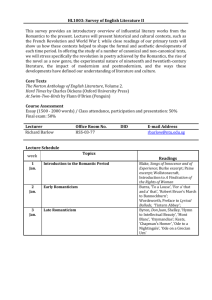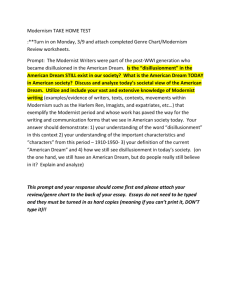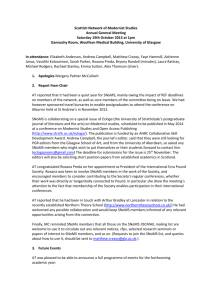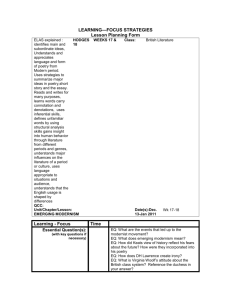Intro to Modernism PPT_rev
advertisement
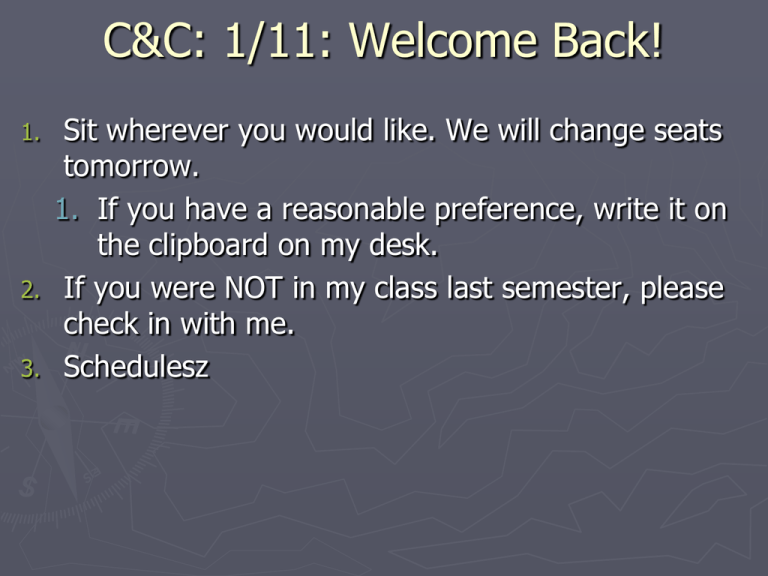
C&C: 1/11: Welcome Back! Sit wherever you would like. We will change seats tomorrow. 1. If you have a reasonable preference, write it on the clipboard on my desk. 2. If you were NOT in my class last semester, please check in with me. 3. Schedulesz 1. 1/11: Welcome Back! Please grab ONE new composition notebook from the box on the back table. 2. Sit wherever you would like. We will change seats tomorrow. 1. If you have a reasonable preference, write it on the clipboard on my desk. 3. If you were NOT in my class last semester, please check in with me. 4. Notebook prep: 1. Front cover: Full Name, English 12: Jennings, per 2. Reserve 2 sets of pgs for Table of Contents 3. Enter: Syllabus: 1L 1. 1/11: Intro Quickwrite pg. 1R ► Respond to each of the following questions individually. 1. What is the purpose of literature in today’s society? 2. Why do people write? 3. Why do people read? 4. How does society influence literature AND how does literature affect society? 1/12: Groups ► Separate into groups by questions number. ► Share your responses and brainstorm other possibilities to your question. ► Synthesize your lists into the best 3-4 answers. ► Poster Paper: Write your question and bullet point your responses. ► Be prepared to share New Year’s Resolutions What are 1-2 specific goals you can make to improve your reading or writing this semester? 2. What is 1 specific goal you have for my class (Modern Lit English 12) this semester? 3. What is 1 specific goal you have for school this semester? Ex: Instead of saying, “I want to be a better writer,” say, “I want to improve my ability to 1. write complete and thoughtful commentary.” Modern Literature TOC: 1/12 2L – 2R Modernist Vocabulary 1/12: 3L-3R (2 sets) Intro to Modernism Notes Intro to MODERNISM: American Literature 1914-1950’s Timeline of Relevant Literary Eras ► Romanticism (1800’s) ► Modernism (early 1900’s) ► Post-Modernism (1950’s-2000) ► Contemporary (2000’s-present) Romanticism (1800’s) ► humans were essentially good and could perfect both themselves and their societies ► Think: “flowers, sunlight, rainbows, beauty of people, happiness, prosperity, God and religion, and the inherent good of people.” ► Emotion and imagination were seen as superior to logic and thought. Romantic Art: The Morning Philipp Otto Runge, 1808 Romantic Literature ► Examples: ► Moby Dick, by Herman Melville, ► The Scarlett Letter, by Nathaniel Hawthorne, and ► poetry by Emily Dickinson “How Happy is the Little Stone” By Emily Dickinson How happy is the little stone That rambles in the road alone, And doesn’t care about careers, And exigencies never fears; Whose coat of elemental brown, A passing universe put on; And independent as the sun, Associates or glows alone, Fulfilling absolute decree In casual simplicity. Based on this knowledge, write 1-2 poetic lines in the style of Romanticism. ► My example: I walked along the babbling brook, eyes wide and heart profound; The sun was peeking through the clouds, and my lover’s song in the air, abound. Why do these lines demonstrate Romanticism? ►Emotional, flowery language, beauty, happiness, etc. Most often, a new literary movement is birthed from 1 of 2 ways: 1. 2. ► As a reaction or contrast to a previous literary movement or way of thinking As a reaction to historical events of the time *Modernism and Modernist styles are contrasted with Romanticism and the romantic ideas that came before the era. *Overview of Modern Literature ► Mainly darker, with many feelings of abandonment, isolation, fear, and despair. ► Went against Romantic, flowery language, and sought deliberate, and intentional literary choices to make a point. ► Focused on the individual psyche and individuals’ interpretations of literature in making personal meaning. ► Questioned established entities of religion, politics, and social systems. ► Reactionary – birthed primarily of the historical contexts of the time period. Causes of the Modernist Temper: 1. 2. 3. 4. 5. 6. 7. WWI 8. Growth of Modern Science Urbanization 9. Influence of Austrian Industrialization Sigmund Freud Immigration (1856-1939) Technological 10. Influence of German Evolution Karl Marx (1818The Great Depression 1883) WWII 1/12: Freewrite – 5 minutes pg. (Continue on pg. 3) ► Without stopping, summarize what you learned about Modernism, so far, from today’s notes. ► Based on what you know already, what do you think Modernist Literature will be like? MODERNISM: American Literature 1914-1950’s Causes of the Modernist Temper: ► WWI ► Urbanization ► Industrialization ► Immigration ► Technological Evolution ► Growth of Modern Science ► Influence of Austrian Sigmund Freud (18561939) ► Influence of German Karl Marx (1818-1883) ► The Great Depression ► WWII WWI WWI: 1914 - 1918 ► Caused American artists and thinkers to experience the brutal actualities of largescale modern war and the consequences that followed. ► The senses of a great civilization being destroyed or destroying itself, of social breakdown, and of individual powerlessness became part of the American experience as a result of its participation in WWI ► resulted in feelings of fear, discrimination, despair. new term, une generation perdue, came to be used to describe the generation of men and women who came to maturity between WWI and the Depression of the 1930s. ► Coined by writer Gertrude Stein, this phrase described the dislocation, rootlessness, and disillusionment experienced in the wake of the war. ► Stein later expanded the meaning of the phrase in conversation with Ernest Hemingway, saying that his was a decadent generation that was drinking itself to death. ► It applied to all Americans who, after the war, found life in the United States to be shallow, empty, vulgar, and unfulfilling. ►A URBANIZATION ► The Urbanization migration of people from rural farm lands to the urban cities in order to seek out work ► led to job opportunities in new bustling cities ► technological advancements in transportation, sanitation, and engineering, which led to an improved standard of living. ► Was the cause of “ghettos” –pockets of the city where multiple families lived in small, impoverished housing developments to live in the city where they worked. Were usually ethnically and culturally grouped, which led to much discrimination. INDUSTRIALIZATION Industrialization and the Industrial Revolution ► 1877-1913 ► major changes in agriculture, manufacturing, mining, transportation, and technology ► had a profound effect on productivity ► Caused a spike in the use of child labor and resulted in the creation of child labor laws. IMMIGRATION Large scale immigration (both foreign and domestic) occurred as people flocked to booming cities looking for work and “The American Dream.” ► Between 1880 and 1920, some 23 million immigrants came to a country that numbered only 76 million in 1900. ► Immigrants made up 15% of the total population in 1900; in the first decade of the 20th century, immigrants constituted nearly 70% of industrial workforce. ► IMMIGRATION ► Oscar Handlin states, “Once I thought to write a history of the immigrants in America. Then I discovered that the immigrants were American history.” The S.S. Patricia, an Atlantic liner, full of immigrants. Photo by Edwin Levick, 1906. TECHNOLOGICAL EVOLUTION Technological Evolution ► Telephones and electricity in homes changed the gap between better- and worse-off Americans. Those without electricity and phones were, literally, out of the network. ► Phonograph record and record player, the motion picture which acquired sound in 1929, and radio ► Automobile: millions of jobs were created; geography of the nation was altered by a new system of highways, which changed measure of distance, doomed some small towns to obscurity, and, put others, literally, on the map; made interstate trucking an alternative to railroading, cities changed shapes, suburbs came into being. GROWTH OF MODERN SCIENCE Scientists became aware that… ► ► ► ► ► ► ► the atom was not the smallest unit of matter matter was not indestructible both time and space were relative to an observer’s position some phenomena were so small that attempts at measurement would alter them Some outcomes could be predicted only in terms of statistical probability the universe might be infinite in size and yet infinitely expanding In short, much of the commonsense basis of nineteenth-century science had to be put aside in favor of far more powerful but also far more complicated theories. The prevalent assumption was that nonscientific thinking could not explain anything. SIGMUND FREUD (1856-1939) Austrian psycho-analyst who invented the use of psychoanalysis to study one’s “unconscious” or “subconscious.” ► Theorized about the individual psyche ► Much of his philosophies were rooted in unacceptable sexual nature and desires that stemmed form birth, are repressed or locked away, and left lifelong scars on the adult personality. ► “forbidden” desires, traumas, and emotions were locked in the unconscious, but unlocking and understanding them could give clarity to certain personality behaviors ► KARL MARX (1818-1883) Believed that all human behaviors could be explained by economic desires. ► Society was broken into class systems (Power class, Working class, Poor) etc. ► Americans who thought of themselves as Marxists in the 1920s and 1930s identified with the world’s workers and with a society in which workers would control the means of production. ► In other words, power should be in the hands of the worker, not the boss. The workers are the means of production and, yet, they are being paid the least. ► “The history of all hitherto existing society is the history of class struggles.” ► INFLUENCES OF FREUD AND MARX ► Modernist writers concerned themselves with the inner being more than the social being and looked for ways to incorporate these new views into their writing. ► Modernist writers looked inside themselves for their answers instead of seeking truth, for example, through formal religion or the scientific assumptions of previous eras. ► Marxism showed artists that the individual was being lost in a mass society. ► Although Marx and Freud didn’t necessarily agree analytically, both seemed better suited to explain the terrible things that were happening in the twentieth century through their philosophies. 1920’s: THE JAZZ AGE To F. Scott Fitzgerald it was an “age of miracles, an age of art, an age of excess, an age of satire.” 1930’s: THE DEPRESSION “True individual freedom cannot exist without economic security and independence. People who are hungry and out of a job are the stuff of which dictatorships are made.” – Franklin D. Roosevelt The Great Depression ► Stark contrast to the excess of “The Roaring Twenties” ► After the fall of the stock market, widespread panic set in. Banks collapsed, people couldn’t access money they had in the bank, and many people were left jobless, homeless, and hungry. ► Caused many “ghost towns” as people left cities looking for something better. ► Once again, people felt isolated, disillusioned and in despair. WWII (1939-1945) WWII (1939 – 1945) ► Americans were, once again, involved in the atrocities of war. ► Horrific events of the Holocaust, concentration camps, gruesome genocide, terrors of new wartime technology (bombs, fighter planes) and general fear added to the ideas of disillusionment, despair, and isolation. ► Caused many to question religion, politics, and the good of humanity all over again. SHIFTS IN THE MODERN NATION ► from country to city ► from farm to factory ► from native born to new citizen ► introduction to “mass” culture (pop culture) ► continual movement ► split between science and the literary tradition (“science vs. letters”) 1/13: Summary and Discussion (p.3) ► Summarize the causes and influences of the Modernist movement and describe your feelings about the time period. Critical Thinking / Discussion Protocol Time Presentation Presenter’s share their quickwrite response and their opinion; Audience listens ONLY! 1 minute Notes Audience takes notes on pg. __ about the presenter’s Point of view; presenter waits – no discussion 1 minute Audience Commentary Audience responds to the presenter’s ideas with what they like, dislike, or agree/disagree with. Presenter listens. 1 minute Reflection/ Final Commentary Final discussion point on the topic – anyone may speak within the group, presenter responds to the audience’s comments 1 minute Characteristics of Modernist Literature 1/19: 4L-4R (2 sets) Characteristics of Modern Lit Notes THE SPIRIT OF MODERNIST LITERATURE ► Previously sustaining structures of human life, whether social, political, religious, or artistic, had been either destroyed or shown up as falsehoods or fantasies. Therefore, art had to be renovated. ► Modernist writing is marked by a strong and conscious break with tradition. It rejects traditional values and assumptions. ► “Modern” implies a sense of alienation, loss, and despair. ► Writers exhibited a skeptical, apprehensive attitude toward pop culture; writers criticized and deplored its manipulative commercialism (aka “buying into” anything mainstream or popular – the O.G. hipsters... ) ► Literature, especially poetry, becomes the place where the one meaningful activity, the search for meaning, is carried out; and therefore literature is, or should be, vitally important to society. Modernists believed that we create the world in the act of perceiving it. CHARACTERISTICS OF MODERNIST WRITING A movement away from realism into abstractions ► Deliberately complex, forcing readers to be very welleducated in order to read these works ► A high degree of self-consciousness ► Questions the nature of being and what is the source of meaning ► A breaking with tradition and conventional modes of form, resulting in fragmentation and bold, highly innovative experimentation ► A variety in content due to instability of surrounding world, so artists were more subjective and opinionated ► Themes of Modernism ► Isolation, *This is an important slide* loneliness, anxiety, and dislocation ► Disillusionment def: a feeling of disappointment resulting from the discovery that something is not as good as one believed it to be. ► The benefits and consequences of “The American Dream” ► Disintegration of social norms such as politics, the family unit, religion, and the inherent sense of the ‘good’ of humanity. ► Focus on the individual’s thoughts, psyche, and search for personal meaning. TECHNIQUES IN MODERNIST WORKS The modernists were highly conscious that they were being modern—that they were “making it new”—and this consciousness is manifest in the modernists’ radical use of a kind of formlessness. 2. Modernist Writers used various techniques to depict their themes: 1. Collapsed plots Fragmentary techniques Shifts in perspective, voice, and tone Stream-of-consciousness point of view Associative techniques Elements of style: (Ambiguities, symbolism, diction, figures of speech, sentence structure, syntax, etc.) COLLAPSED PLOTS ► Plot will seem to begin randomly, to advance without explanation, and to end without resolution, segments one after the other with little transition or explanation ► Plot lines are often complex, rather than linear or chronological (use of flashbacks, dreams, and jumps in the plot) ► It will suggest rather than clearly or blatantly state things, making use of symbols and images instead of statements. ► The reader must participate in the making of the poem or story by searching for meaning ► Traditional elements (setting, dialogue, resolution) are gone. FRAGMENTARY TECHNIQUES ► Compared with earlier writing, modernist literature is notable for what it omits—the explanations, interpretations, connections, summaries, and distancing that provide continuity, perspective, and security in traditional literature. ► The idea of order, sequence, and unity in works of art is sometimes abandoned. ► The long work will be an assemblage of fragments, the short work a carefully realized fragment. Some modernist literature registers more as a collage. This fragmentation in literature was meant to reflect the reality of the flux and fragmentation of one’s life. ► Fragments will be drawn from diverse areas of experience. Vignettes of contemporary life, chunks of popular culture, dream imagery, and symbolism drawn from the author’s private repertory of life experiences. A work built from these various levels and kinds of material may move across time and space, shift from the public to the personal, and open literature as a field for every sort of concern. SHIFTS IN PERSPECTIVE, VOICE, AND TONE ► The inclusion of all sorts of material previously deemed “unliterary” in works of high seriousness involved the use of language that would also previously have been thought improper, including representations of the speech of the uneducated and the inarticulate, the colloquial, slangy, and the popular. The traditional educated literary voice, conveying truth and culture, lost its authority. ► Prose (poetry, short stories, novels) writers strove for directness, compression, and vividness. They were sparing of words. The average novel became quite a bit shorter than it had been in the nineteenth century. ► Modern fiction tends to be written in the first person or to limit the reader to one character’s point of view on the action. STREAM-OF-CONSCIOUSNESS ► Stream-of-consciousness is a literary practice that attempts to depict the mental and emotional reactions of characters through the practice of reproducing the unedited, continuous sequence of thoughts that run through a person’s head, most usually without punctuation or literary interference. ► Ultimately, S.O.C. writing is long, ramblings of the brain, (more so like we think than how we speak,) often sounds random, and lacks punctuation. STREAM-OF-CONSCIOUSNESS ► The writers of the stream-of-consciousness novel seem to share these common assumptions: existence of human beings is found in their mentalemotional processes, not in the outside world (so look into the psyche) that this mental-emotional life is disjointed and illogical, & that a pattern of free psychological association determines the shifting sequence of thought and feeling ASSOCIATIVE TECHNIQUES ► Modernists sometimes used a collection of seemingly random impressions and literary, historical, philosophical, or religious allusions with which readers are expected to make the connections on their own. ► Writers associate or relate their own ideas with previous ideas of others. Eliot’s The Waste Land is arguably the greatest example of this allusive manner of writing; it includes a variety of Buddhist, Christian, Greek, Judaic, German and occult references, among others. ► T.S. ►A IMAGISM reaction against a the previously “weak” and “soft” Romantic art. ► The imagists aimed to strip away poetry’s tendency toward dense wordiness and sentimentality and to crystallize poetic meaning in clear, neatly juxtaposed images. Like a snapshot that clearly shows what is happening without all the flowery, fake, Romantic fluff ► Early influences on the imagists included the symbolist poets, classical Greek and Roman poetry, and Chinese and Japanese verse forms, in particular the haiku. Modernism can be seen through other “isms” that arose in art: ► Fauvism ► Cubism ► Dadaism ► Expressionism ► Surrealism FAUVISM ► A number of French artists such as Rouault, Derain, Dufy, Vlaminck, and Braque who grouped around Matisse and exhibited together from 1905 to 1907. ► The outraged critical reaction to their free use of color and distortion of form led to their being called Les Fauves (“the wild beasts”). ► characterized by artists’ use of strident color and seemingly wild brushwork. Henri Matisse. Woman with a Hat, 1905. CUBISM ► Objects Georges Braque. Woman with a Guitar, 1913 are broken up and reassembled into abstract forms. ► Analytic cubism used geometric shapes rather than color to represent the real world. ► Incorporated the idea of collage: pulling together a variety of materials to create a new whole. ► Cubist poetry attempts to do in verse what cubist painters do on canvas; take the elements of an experience, fragment them, and then rearrange them in a meaningful new ways. DADAISM ► A movement in Europe during and just after WWI, which ignored logical relationships, argued for absolute freedom, and delivered itself of numerous provocative manifestoes. ► It was founded in Zurich in 1916 by Tristan Tzara with the destructive intent of demolishing art and philosophy intended to replace art & philosophy with intentional madness as a protest against the insanity of the war. Marcel Duchamp. Nude Descending a Staircase, No. 2 1912 EXPRESSIONISM A subjective art form in which an artist distorts reality for an emotional effect. ► The growing mass and mechanism ► of society, with its tendency to depress the value of the arts, made artists seek new ways of making art forms valuable ► The Scream. 1893. Edvard Munch Expressionistic drama flourished in the 1920s and was marked by: unreal atmosphere; nightmarish action; distortion and oversimplification; the deemphasis of the individual; antirealistic settings; the spiritual awakening and sufferings of their protagonists; and staccato, telegraphic dialogue. Expressionism (continued) ► In Modern poetry, the revolt against realism, the distortion of the objects of the outer world, and the violent dislocation of time sequence and spatial logic was created in an effort to accurately, but not representationally, show the world as it appears to a troubled mind. SURREALISM A movement in art emphasizing the expression of the imagination as realized in dreams and presented without conscious control. ► Paintings were not literal depictions of the known world but disconcerting, “realistic” representations of the subconscious. ► Surrealism is often regarded as an outgrowth of Dada. ► The Persistence of Memory. 1931. Salvador Dali Works Cited ► ► ► ► Baym, Nina, ed. The Norton Anthology of American Literature. New York: W.W. Norton & Company, Inc., 1998. Harmon, William, and C. Hugh Homan, eds. A Handbook to Literature. New Jersey: Prentice-Hall, Inc., 1996. Kimmelman, Burt, ed. The Facts on File Companion to 20th Century American Poetry. New York: Facts on File, Inc., 2005. Lathbury, Roger. American Modernism (1910-1945): American Literature in its Historical, Cultural, and Social Contexts. ► Backgrounds to American Literature Series. New York: Facts On File, Inc., 2006. Siepmann, Katherine Baker, ed. Benét’s Reader’s Encyclopedia. New York: Harper-Collins Publishers, Inc., 1948. Modernism Vocabulary: Pg 2L-2R 1. 2. 3. 4. 5. Abandonment Abstract Alienate Anxiety Associate Assumptions/ Assume 7. Conscious/Su bconscious/U nconscious 8. Context 6. 9. 10. 11. 12. 13. 14. 15. 16. 17. 18. 19. Despair Disillusionment Disintegration Dislocation Distortion 20. Isolation 21. Psyche 22. Psychoanalysis 23. Reaction Fragmentation Ghettos Industrialization Influence Intentional Interpretation 24. 25. 26. 27. 28. Repression/r epress Subjective Theories Tradition Urbanization Practice with Modernist Vocabulary ► In groups of 6 ► Complete the word cube to the right on an index card for each of your words ► Then, add your word to the class tier chart ► When everyone in your group has completed their cubes, take a picture of them. Put the vocab word on the blank side of the card Tenses or variations of the word Easy, tier 1 definition of the word Quick pic Describe the connection between this word and Modernism For Homework… 1/21 ► Transfer your vocab cube pictures to an index card. ► You should have 1 card each of the 28 (or, technically, 31) vocabulary words. ► Study, study, study! ► These will be due on Friday, 1/22! Modernism Vocabulary: 1. 2. 3. 4. 5. Abandonment: Being forgotten, deserted, or left alone. Abstract Not concrete; theoretical; something you cannot see or touch Alienate To push away; to be unfriendly or hostile Anxiety Uneasy feelings; being on edge Associate To connect or join 6. 7. 6. Assumptions / Assume To suppose without having evidence Conscious Awareness; alertness Subconscious Partial awareness; not completely aware Unconscious Without alerted control; not aware Context The surrounding events; setting Despair Complete hopelessness, gloom 10. Disillusionment Disappointment after finding out something isn’t as good as you may have previously thought 11. Disintegration Falling apart; crumbling 12. Dislocation Separation; not having a permanent location or place 13. Distortion Changing the shape or view of something 9. Fragmentation Breaking off into parts 15. Ghettos Parts of a city where minorities of similar cultures live together in extremely close quarters 16. Industrialization Shift from agricultural business (farming) to industries like factories and machinery 17. Influence A power affecting a person, event, or thing (oftentimes without direct contact) 18. Intentional Done in a way that is planned by specific choice 14. Interpretation An explanation 20. Isolation Separating one thing from another 21. Psyche The individual, cognitive mind involving the memory, soul, and personality of a person 22. Psycho-analysis Study of the brain involving therapy that focuses on one’s unconscious thoughts 23. Reaction Feelings or actions in response to something that occurs 19. Repression/repress Not allowing yourself to remember something, whether on purpose or unconsciously; usually because of a harmful or traumatic event 25. Subjective Based on feelings or opinions instead of objective facts 26. Theories Principles used to explain something 27. Tradition Belief or behavior passed down from generations 28. Urbanization Transition of life from rural farmland to city living 24. 1/25: Examples of Modernism Minstrel Man by Langston Hughes, 1925 Because my mouth Is wide with laughter And my throat Is deep with song, You did not think I suffer after I've held my pain So long. Because my mouth Is wide with laughter You do not hear My inner cry: Because my feet Are gay with dancing, You do not know I die. Modernist Perspective Freudian Perspective Marxist Perspective a. Who is the speaker and who are they talking to? b. Why are they suffering? What factors have led to and continue their suffering? c. What is a possible theme of this poem? Explain and use textual evidence to support your idea. 1/26: “Araby” by James Joyce Characteristic 1. Modernist Influences 2. Modernist Theme 3. Collapsed Plot 4. Fragmentation 5. Perspective 6. Stream-ofConsciousness 7. Associative Techniques Textual Example Explanation Minstrel Man by Langston Hughes, 1925 Because my mouth Is wide with laughter And my throat Is deep with song, You did not think I suffer after I've held my pain So long. 1 Because my mouth 9 Is wide with laughter You do not hear 4 My inner cry: 12 Because my feet Are gay with dancing, You do not know 8 I die. 16 Practice with Modernist Analysis ► Analyze the poem “Minstrel Man” for ONE of the following elements of style: 1) imagery, 2)tone, 3)sentence structure, 4) symbolism. What stylistic element are you analyzing? 2. Give 2 textual examples of how the element is used throughout the poem and EXPLAIN your examples with reasoning. 3. Explain the effect that the element of style has in developing your personal and Modernist interpretation of the poem. ► Then, do the same for “Araby.” 1. Quiz Game Creation ►½ sheet of paper and write your name ► Create 4 test questions as a review for our Modernism Exam: 1. Two questions from the intro to Modernism notes 2. One question from the vocab 3. One question from the Elements of Style notes ► Write the correct answer and/or answer choices under the question. 1/28: Causes of the Modernist Temper: ► In groups, become an expert on your cause and its Modernist influence. ► On a poster paper, writw the following: 1. Cause, Time period and region 2. Summary points of the historical context/event/or person 3. Main ideas or ideals 4. How do you think your cause may have influenced literature/ art, and American life? 5. Be prepared to share ► ► ► ► ► ► ► ► ► WWI Urbanization Industrialization Immigration Technological Evolution Influence of Austrian Sigmund Freud Influence of German Karl Marx The Great Depression WWII Growth of Modern Science Abandonment Repression Influence Disillusionment Theory Abstract Subconscious Ghettos Intentional Conscious Interpretation Fragmentation Unconscious Associate Isolation Psyche Assumptions Alienate Subjective Distortion Despair Disintegration Anxiety Urbanization Reaction Tradition Industrialization Dislocation Psychoanalysis Context
